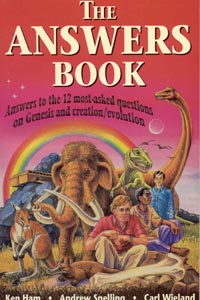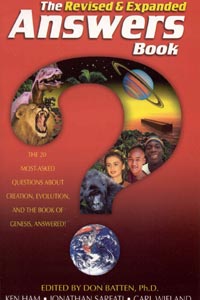| Site Map | Contacts | Links | Newsletter | |
Other Views:
Ken Ham
Ken Ham Flip-flops in his new revised & expanded edition of The Answer Book.
 |
 |
| The Answer Book, 1990 | The Answer Book, 2000 |
Continental Drift
In the first edition there is a whole chapter (2) showing how wrong continental drift and plate tectonics is. In the revised edition chapter 11, there is evidence for Biblical plate tectonics that occurred during the flood and afterward.
Speed of Light
The first edition has several pages supporting the slowing down of the speed of light (pp.189-192). Norman's and Setterfield's evidence is set forth. In the revised edition it is reduced to three paragraphs (p.97) with the conclusion, "In short, none of the theory's defenders have been able to answer all the problems raised"(p.97).
Dinosaurs Today
Lock Ness Monster (1990, 35)
There is no mention of the Lock Ness Monster as a possible plesiosaur as in the first edition (p.35).
Plesiosaur sightings (1990, 39)
In his new edition there is no reference to plesiosaur sightings except to note that the supposed Japanese plesiosaur was not a plesiosaur (p. 267 note). Other carcasses have washed up on the beaches of New Zealand which turned out to be basking sharks.
Lack of Moon Dust
In a footnote (p.267) of the revised edition, the lack of Moon dust should not be used as evidence for a young universe. May I be so bold as to suggest a chapter on all the evidence that was once thought to indicate a young earth, but no longer does instead of a very small footnote.
Conclusion
I am glad that Ken Ham has changed his mind about Continental Drift and Plate Tectonics. I am glad that he no longer supports the theory that light has slowed down. I am glad that he no longer claims the sightings above as plesiosaurs, but there are many, many more problems with the book that still need to be corrected.
--written by Dr. Stephen C. Meyers
Problems with the Revised & Expanded Answers Book
Dinosaur Blood???
Three times in this revised book there is the reference to dinosaur blood being found (86, 193, 246-7). The key article that is quoted is "The Real Jurassic Park" by Mary Schweitzer and Tracy Staedter and published in Earth, June 1997, pages 55-57. It seems to me that Ken Ham has not read this article very carefully.
First of all, the article does not claim to have found dinosaur blood. The authors conclude, "So far, we think that all the evidence supports the notion that our slices of T. rex could contain preserved heme and hemoglobin fragments. But more work needs to be done before we are confident enough to come right out and say, 'Yes, this T. rex has blood compounds left in its tissues'"(p.57).
Secondly, blood cells can easily fall apart, but the proteins heme and hemoglobin can survive for a very long time. A heme is a very stable structure of a ring like organic compound called porphyrin bound to an iron atom (p.56). Porphyrins have been found in sediments dating back to the Carboniferous Period which was 286 million years ago (p.56). This is at least 100 million years before T. rex. So it should not be surprising to find heme.
Thirdly, there are major problems in finding dino DNA because DNA is everywhere. The authors state, "Indeed, running the T. rex bone through a battery of tests, we discovered DNA--but it was the DNA of fungi, bacteria and insects, clearly not of dinosaurs" (p.56).
Finally, there is a lack of understanding of the formation of fossils. The T. rex bone is called "fresh" as if the T. rex just recently died (p.246). The dinosaur bones are also called "Unmineralized ('Unfossilized')" (p.193). This is simply not true. Most of the bone was mineralized except deep down inside the bone (p.55), probably because water had penetrated the inside of the bone.
Process of Fossilization
- Original Organic material
- Permineralization - A continuing process where: a. Water causes chemical reactions to change organic to inorganic material. b. Bacteria causes chemical reactions to change organic to inorganic material.
- Petrification -This is where the organic material has been completely (100%) turned into inorganic material-stone.
This process can take a very very long time, or a relatively short time if conditions are right.
In conclusion, finding dinosaur heme or hemoglobin does not mean that dinosaurs lived recently, since these proteins can survive for a very very long time.
Written by Dr. Stephen C. Meyers 1-2-2001.
